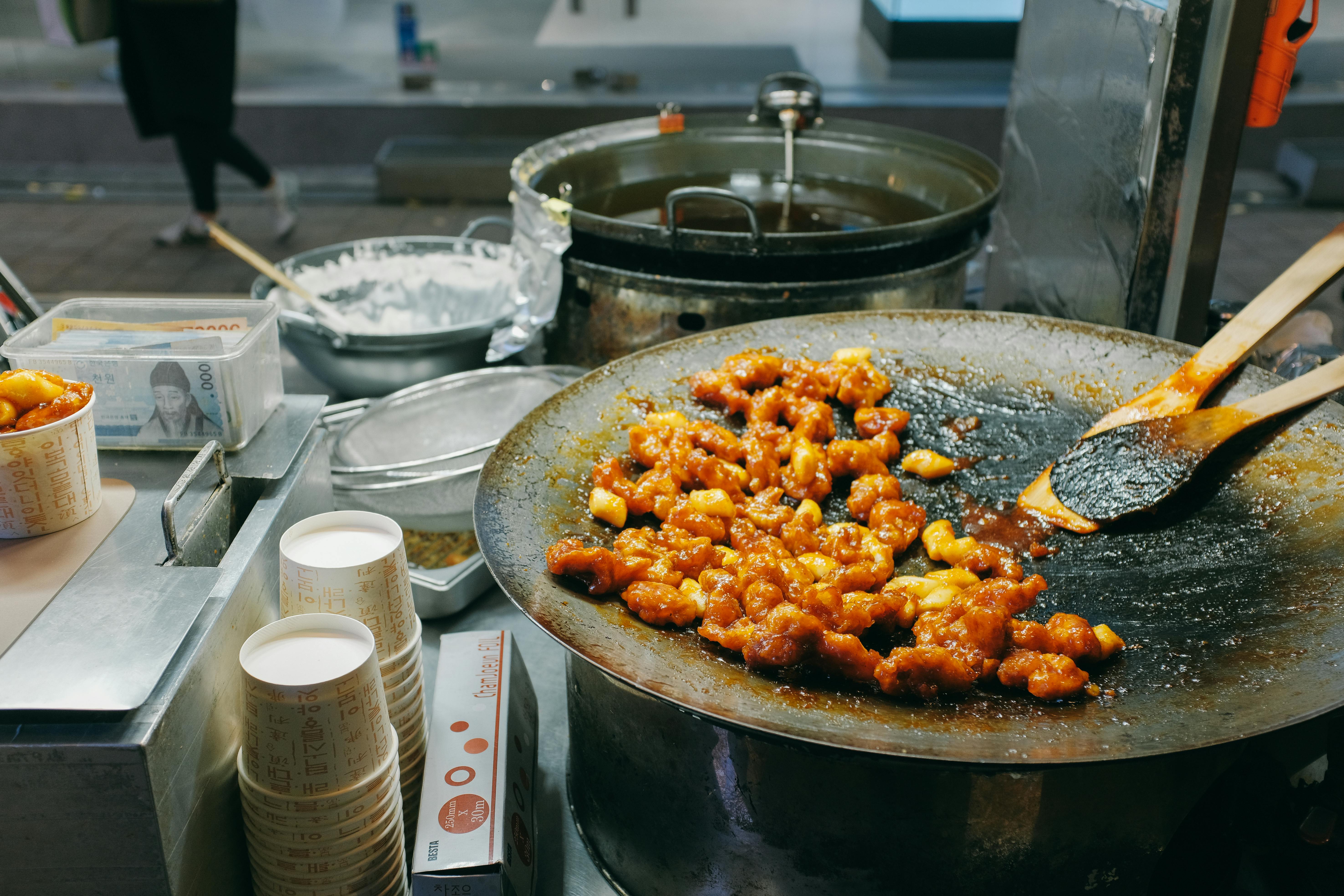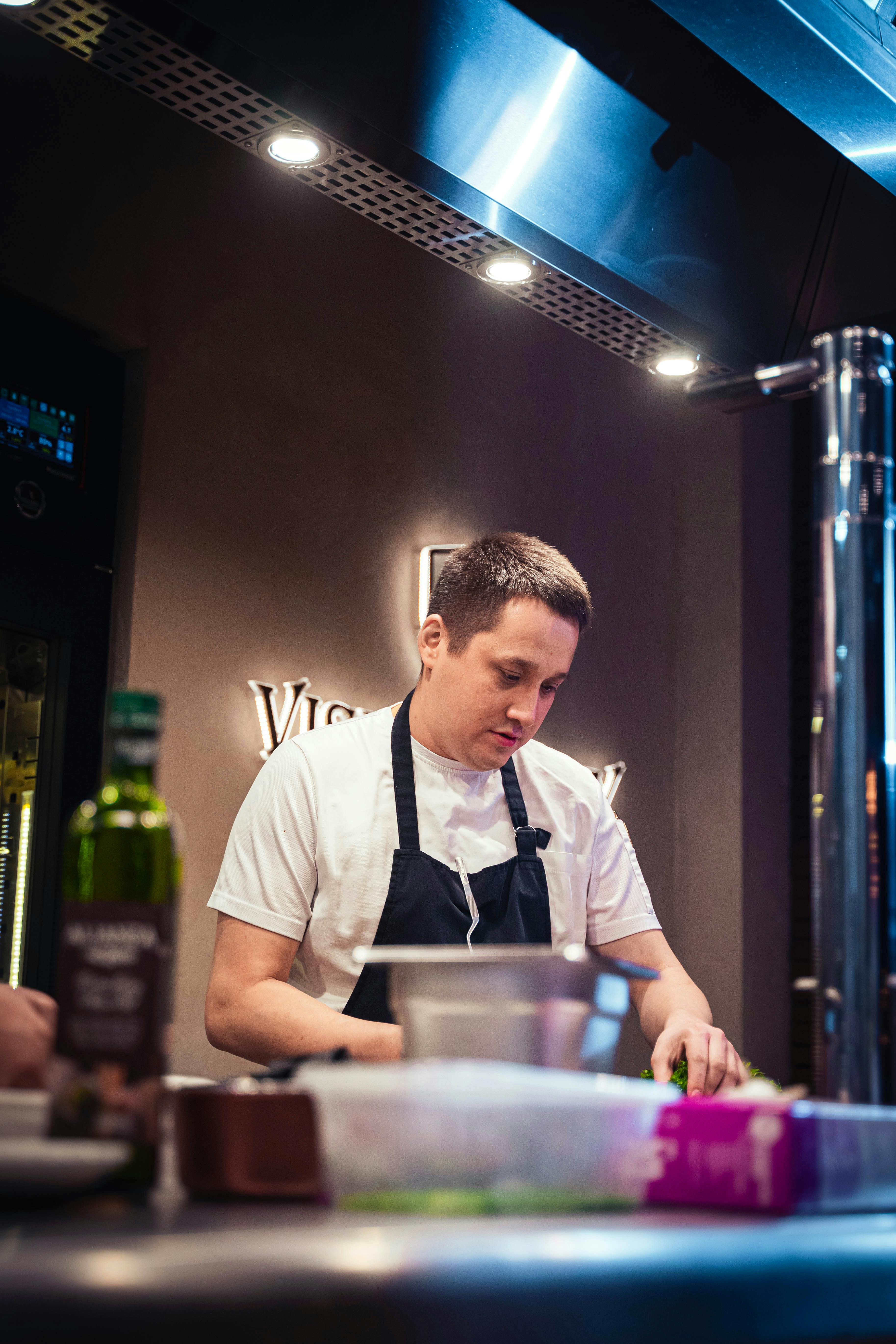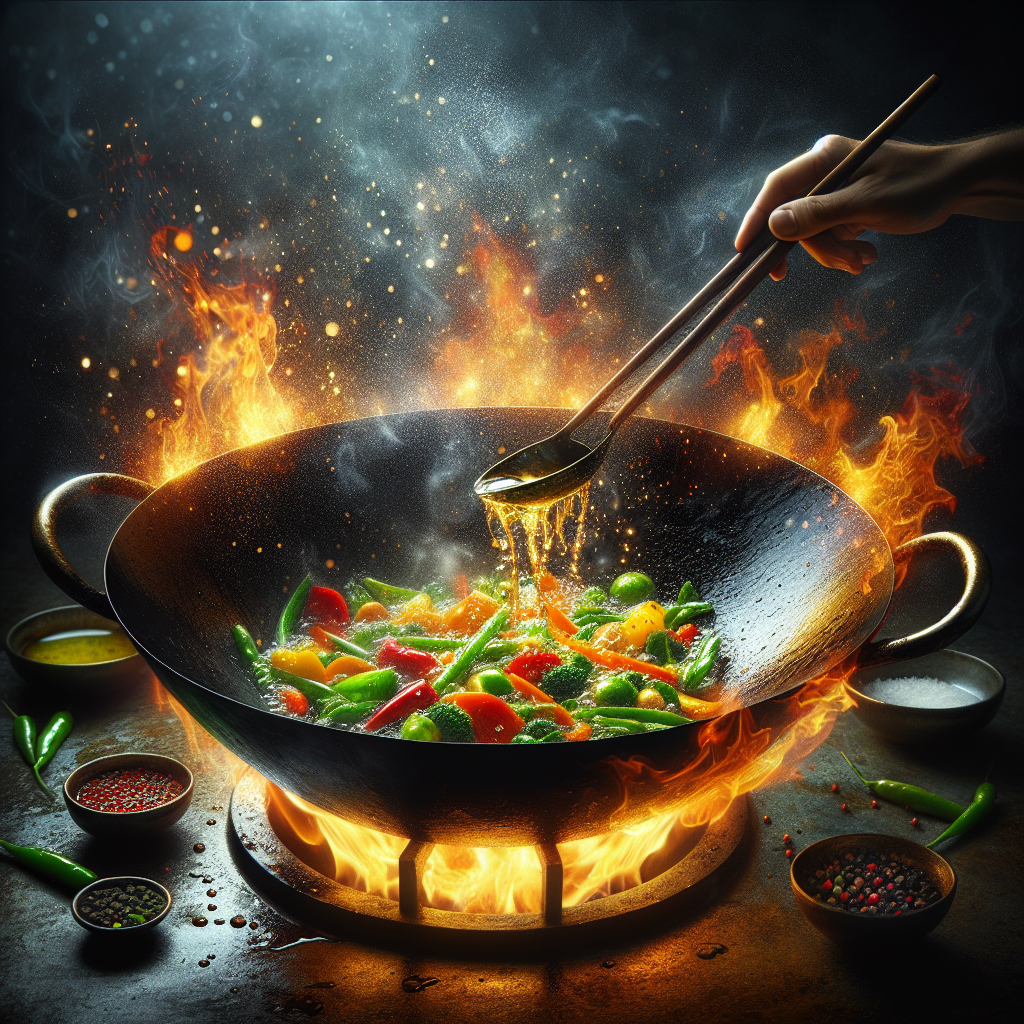Imagine being able to recreate the delicious flavors of your favorite Asian dishes right in your own kitchen. With the art of wok cooking, this is not only possible, but also surprisingly simple. By harnessing the power of high heat, you can achieve a unique flavor profile that is unmatched by any other cooking method. In this article, we will explore the secrets of wok cooking, from choosing the right wok to mastering the techniques that will elevate your dishes to a whole new level. Get ready to embark on a culinary adventure that will bring the sizzle and aroma of Asian cuisine straight to your table.
Choosing the Right Wok
When it comes to wok cooking, choosing the right wok is essential for achieving delicious results. There are several factors to consider when selecting a wok, including the material, size, shape, and handle type.

Material
The material of the wok plays a significant role in its cooking performance and durability. Traditional woks are made from carbon steel, which is known for its excellent heat conductivity. Carbon steel woks heat up quickly and distribute heat evenly, allowing for efficient cooking. Cast iron woks are also a popular choice, as they retain heat well and provide excellent heat retention. However, they are heavier than carbon steel woks. Non-stick woks are another option, which are convenient for easy cleanup, but may not provide the same high heat capabilities.
Size
The size of the wok you choose depends on your cooking needs. Woks typically range from 12 to 14 inches in diameter, with larger woks being suitable for cooking larger quantities of food. If you plan on cooking for a smaller group or have limited storage space, a smaller wok may be more practical. Consider the size of your stovetop burner as well, as a wok that is too large may not sit securely and evenly on the heat source.
Shape
Woks come in various shapes, with the most common being round-bottomed and flat-bottomed. Round-bottomed woks are traditional and are designed for use on a wok ring or wok stand, which allows the heat to be concentrated at the center of the wok. Flat-bottomed woks, on the other hand, are compatible with modern stovetops, making them more accessible for everyday use. The shape you choose depends on your cooking setup and personal preference.
Handle Types
Woks can have different handle types, such as long wooden handles or loop handles. Long wooden handles are good for maneuverability and provide a secure grip, but they may require oven mitts when cooking on high heat. Loop handles are shorter and often found on Cantonese-style woks, making them easier to store and handle. Consider your comfort and preference when selecting the handle type that suits you best.
Preparing the Wok
Before you start cooking with your new wok, it is essential to season it properly. Seasoning creates a non-stick surface and enhances the flavor of your dishes. Cleaning and maintaining your wok is also crucial for its longevity and cooking performance.
Seasoning the Wok
To season your wok, start by washing it with warm water and a small amount of mild dish soap to remove any manufacturing residue. Rinse thoroughly and dry it completely. Next, heat the wok over medium-high heat until it is very hot. Add a small amount of cooking oil and swirl it around the inside of the wok, using a heat-resistant brush or paper towel to coat the entire cooking surface. Let the oil heat for a few minutes until it starts to smoke, then carefully pour it out and wipe off any excess oil. Repeat this process several times to build up a seasoned layer on the wok’s surface. After seasoning, avoid using abrasive sponges or harsh cleaning agents, as they can remove the seasoned layer.
Cleaning and Maintenance
After each use, it is important to clean your wok properly to remove any food residue and maintain its seasoning. To clean a seasoned wok, use a soft sponge or brush and warm water. Avoid using any abrasive materials that can damage the seasoned surface. If there are stubborn food particles stuck to the wok, you can heat it over low heat and add a small amount of water to loosen them. Once clean, dry the wok thoroughly to prevent rusting. If the wok develops rust or loses its seasoning over time, you may need to repeat the seasoning process.
Preparation and Ingredients
To create delicious wok dishes, it is important to prepare your ingredients properly and choose the right flavors to complement your dish. Understanding cutting techniques, marinades and sauces, and selecting high-quality ingredients will elevate your wok cooking game.
Cutting Techniques
When preparing ingredients for wok cooking, it is essential to have proper cutting techniques. Julienne, dice, and slice ingredients uniformly to ensure even cooking. Cutting ingredients into smaller pieces allows for quicker cooking and better incorporation of flavors. Invest in a sharp chef’s knife or a cleaver for precise cuts.
Marinades and Sauces
Marinating proteins and preparing flavorful sauces are key to adding depth and complexity to your wok dishes. Create marinades with soy sauce, ginger, garlic, and other aromatic ingredients to infuse your proteins with flavor. Experiment with different combinations of sauces, such as sweet and sour, hoisin, oyster, or black bean sauce, to enhance the taste of your stir-fries. Be sure to balance the flavors and adjust the seasoning according to your taste preferences.
Choosing the Right Ingredients
Selecting fresh and high-quality ingredients is crucial for achieving delicious wok dishes. Choose vibrant vegetables that are in season and protein sources like chicken, beef, shrimp, or tofu that are fresh and well-trimmed. Consider the texture of your ingredients when planning your dish, ensuring a mix of crunchy, tender, and flavorful components. Keep in mind the cooking time needed for each ingredient to achieve the desired doneness.
Mastering High Heat Cooking
The hallmark of wok cooking is the ability to achieve intense heat that seals in flavors and creates that sought-after wok hei, or the “breath of the wok.” Mastering high heat cooking techniques will elevate your wok dishes to the next level.
Importance of High Heat
High heat is essential in wok cooking for several reasons. Firstly, it allows for quick and even cooking, ensuring that ingredients are cooked just right without overcooking or becoming mushy. Secondly, high heat creates a delicious smoky flavor and char on the ingredients, adding depth and complexity to the dish. Lastly, it allows the ingredients to retain their vibrant colors and textures.

Preheating the Wok
Preheating the wok is a crucial step to achieving high heat cooking. Place your wok on the stovetop over high heat and let it heat up for a few minutes. The wok should be hot enough that water droplets sizzle and evaporate almost instantly upon contact. This step ensures that the ingredients will sear and cook quickly when added to the hot surface, sealing in their natural flavors.
Stir-Frying Techniques
Stir-frying is a popular technique in wok cooking that involves quickly cooking ingredients over high heat while continuously stirring or tossing them. This technique ensures even cooking and develops complex flavors. When stir-frying, start with aromatics like garlic, ginger, and onions, followed by proteins, and finish with vegetables. It is important to keep the ingredients moving constantly to prevent burning and sticking to the wok. Use a spatula or a pair of long wooden chopsticks to toss and stir-fry with ease.
Flavor Enhancements
In addition to high heat cooking, adding flavor-enhancing ingredients and seasonings will take your wok dishes to new heights. Incorporate aromatics, spices, soy sauce, and umami ingredients for a burst of bold flavors.
Aromatics and Spices
Aromatics such as ginger, garlic, shallots, and scallions are the foundation of many wok dishes, offering a fragrant base and enhancing the overall flavors. Spice up your dishes with various spices like chili flakes, Sichuan peppercorns, or five-spice powder. Experiment with different combinations to create unique and vibrant flavor profiles.
Soy Sauce and Other Seasonings
Soy sauce is a fundamental ingredient in wok cooking that adds a savory and umami-rich taste to your dishes. It provides a perfect balance of saltiness and depth of flavor. Experiment with different types of soy sauce, such as light, dark, or tamari, to discover the nuances each brings to your recipes. Other seasonings like fish sauce, hoisin sauce, and rice wine vinegar can also add complexity and depth to your wok dishes.
Umami Ingredients
Umami, the fifth taste sensation, is often sought after in wok cooking. Incorporate umami-rich ingredients like mushrooms, fermented soy products, dried shrimp, or dried scallops to enhance the overall umami flavor in your dishes. These ingredients add a depth of flavor that will leave your taste buds wanting more.
Traditional Wok Dishes
Wok cooking is deeply rooted in traditional Asian cuisines, and there are several classic dishes that showcase the versatility and deliciousness of this cooking technique. Explore these traditional wok dishes to expand your culinary repertoire.
Stir-Fried Noodles
Stir-fried noodles are a staple in many Asian cuisines, such as Chinese chow mein or Pad See Ew from Thailand. The high heat and constant tossing of the wok contribute to the smoky flavor and perfectly cooked noodles. Choose your favorite combination of proteins, vegetables, and noodles, and stir-fry them to perfection.
Fried Rice
Fried rice is a classic wok dish that is popular across various Asian cultures. Use leftover rice and stir-fry it with a combination of vegetables, proteins, and aromatics. The high heat of the wok ensures that each grain of rice is separated and coated with delicious flavors.
Kung Pao Chicken
Kung Pao chicken is a flavorful Sichuan dish that combines tender chicken, peanuts, and dried chili peppers in a savory and slightly spicy sauce. The wok’s high heat allows the chicken to cook quickly while retaining its tender texture, while the peanuts add a crunchy element.
General Tso’s Chicken
General Tso’s chicken is a beloved American-Chinese dish that has gained popularity around the world. The chicken is first coated in a crispy batter and then stir-fried until golden brown. The wok’s high heat ensures that the chicken remains juicy on the inside while achieving a crispy exterior. The sauce, made with a combination of soy sauce, ginger, garlic, and peppers, adds a sweet and tangy flavor to the dish.
Pad Thai
Pad Thai is a famous Thai dish that features stir-fried rice noodles, bean sprouts, tofu, shrimp, or chicken, all cooked to perfection in a wok. The combination of tamarind paste, fish sauce, and palm sugar creates the signature sweet, sour, and savory flavors of this beloved dish.

Beef and Broccoli
Beef and broccoli is a classic Chinese stir-fry that features thinly sliced beef, crisp broccoli, and a savory brown sauce. The wok’s high heat and stir-frying technique ensure that the beef is tender and the broccoli retains its vibrant green color.
Regional Wok Specialties
Different regions have their own unique culinary traditions and wok cooking styles. Explore these regional wok specialties to expand your culinary horizons.
Cantonese Cuisine
Cantonese cuisine is known for its delicate flavors and emphasis on fresh ingredients. Wok dishes in Cantonese cuisine often feature stir-fried seafood, vegetables, and light sauces. Classic Cantonese wok dishes include sweet and sour pork, beef with black bean sauce, and stir-fried snow pea shoots.
Sichuan Cuisine
Sichuan cuisine is famous for its bold and spicy flavors. Sichuan wok dishes often incorporate the use of Sichuan peppercorns, dried chili peppers, and numbing spices. Spicy stir-fried dishes like mapo tofu, kung pao chicken, or Sichuan-style hot pot showcase the heat and numbing sensation characteristic of Sichuan cuisine.
Thai Cuisine
Thai cuisine is renowned for its vibrant and aromatic flavors. Thai wok dishes often feature a combination of fresh herbs, spices, and the Thai holy trinity of flavors – sweet, sour, and spicy. Stir-fried dishes like Thai basil chicken, pad prik king, or green curry stir-fry showcase the unique blend of flavors and ingredients that make Thai cuisine so beloved.
Indian Cuisine
Indian cuisine is diverse and renowned for its complex spice blends and rich flavors. Indian wok dishes, often referred to as “Indo-Chinese” dishes, combine Indian and Chinese flavors. The use of aromatic spices, such as cumin, coriander, and turmeric, combined with soy sauce and chili, creates bold and vibrant flavors in dishes like chili chicken, garlic noodles, or gobi Manchurian.
Wok Cooking Tips and Techniques
To become a wok cooking master, keep these tips and techniques in mind to ensure successful and delicious dishes every time.
Keeping Ingredients Moving
When stir-frying in a wok, it is important to keep the ingredients moving constantly. This prevents uneven cooking and ensures that each ingredient gets evenly coated with the sauces and aromatics. Use a spatula or a pair of long chopsticks to toss and stir-fry with ease.
Proper Seasoning and Stir-Frying Time
Seasoning your dishes properly is crucial for achieving balanced flavors. Taste as you go and make adjustments to the seasonings accordingly. Similarly, pay attention to the cooking time for each ingredient. Overcooking can result in mushy vegetables and tough proteins, while undercooking can leave your ingredients raw or unappetizing.
Using the Right Oil
Selecting the right oil for your wok cooking is important for achieving authentic flavors and preventing sticking. Use oils with high smoke points, such as peanut oil, vegetable oil, or canola oil, that can withstand the high heat of wok cooking. These oils will allow you to achieve the signature wok hei while providing a neutral base for your flavors to shine.
Wok Cooking Safety
Wok cooking involves high heat and quick cooking techniques, so it is important to prioritize safety in the kitchen. Follow these tips to ensure safe and enjoyable wok cooking experiences.
Handling High Heat
Wok cooking requires cooking at high temperatures, so it is crucial to handle the heat carefully. Always use oven mitts or heat-resistant gloves when handling a hot wok to avoid burns. Keep flammable items, such as kitchen towels or curtains, away from the heat source to prevent accidents.
Avoiding Oil Splatters
When cooking with a wok, hot oil splatters can be a safety concern. To prevent oil splatters, gently pat dry your ingredients before adding them to the wok to reduce moisture. Additionally, use long-handled utensils like spatulas or tongs to toss and stir-fry, keeping a safe distance from the sizzling oil.
Proper Ventilation
Wok cooking can generate a significant amount of smoke, so it is important to have proper ventilation in your kitchen. Turn on the range hood or open windows to allow smoke to escape. This will prevent the accumulation of smoke and odors, ensuring a comfortable and safe cooking environment.
Exploring Wok Accessories
To enhance your wok cooking experience, consider investing in some additional accessories that can make the process even more enjoyable and convenient.
Wok Lid
A wok lid is a valuable accessory to have, as it helps control heat and steam during cooking. A lid can be used to trap heat and moisture, allowing for steaming or simmering. Additionally, a lid can be used to keep food warm or as a splatter guard when stir-frying.
Wok Spatula
A wok spatula is designed specifically for wok cooking, with its curved shape and long handle. This specialized spatula allows you to toss and stir-fry ingredients easily, ensuring that everything is evenly cooked. Look for a spatula with a heat-resistant handle and a wide, flat end for optimal stirring.
Wok Ring
A wok ring is a sturdy metal ring that provides stability for round-bottomed woks on a typical stovetop burner. It elevates the wok slightly, allowing for a more stable cooking surface. If you plan to use a round-bottomed wok, a wok ring is a must-have accessory.
Wok Rack
A wok rack is another accessory used for round-bottomed woks. It is a metal rack that can be placed on a stovetop burner to ensure a stable cooking surface for the wok. The wok sits securely on the rack, allowing for efficient heat distribution.
In conclusion, wok cooking is an art form that combines high heat and bold flavors to create delicious and vibrant dishes. By choosing the right wok, mastering high heat cooking techniques, and exploring different regional specialties, you can unlock the true potential of wok cooking. Follow these tips, techniques, and safety practices to become a wok cooking pro and elevate your culinary skills in the kitchen. Happy wok cooking!

